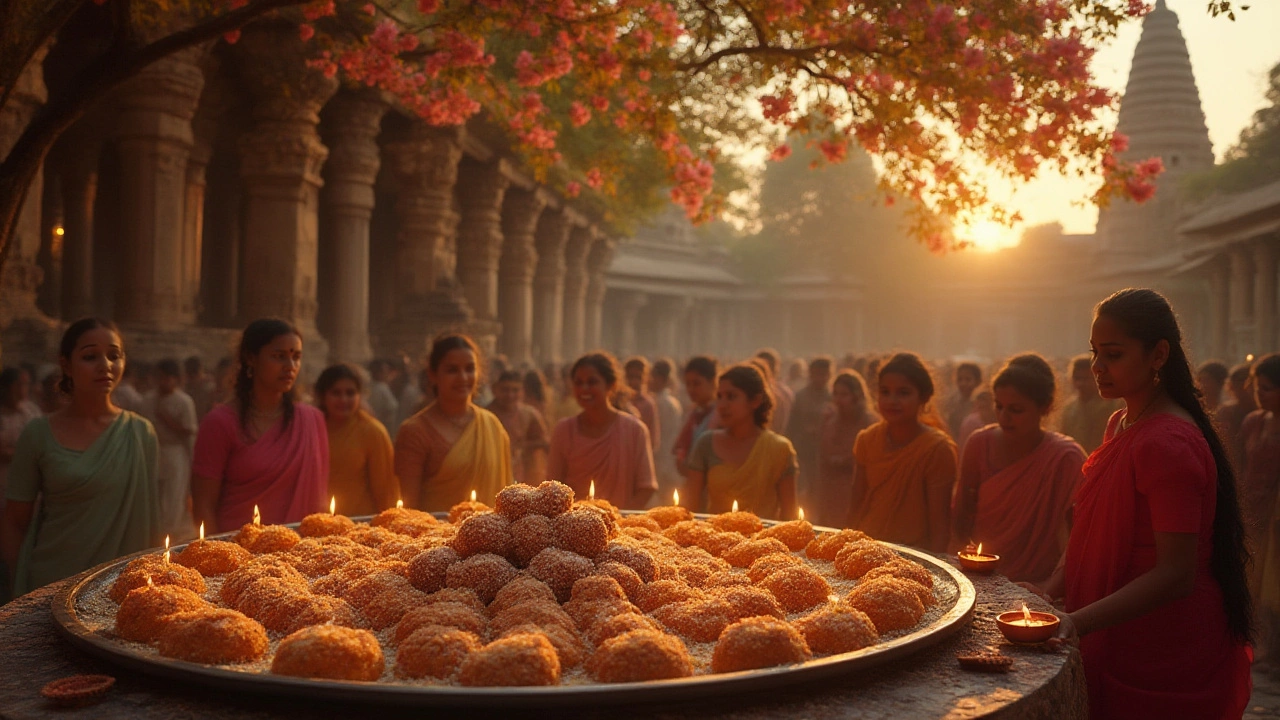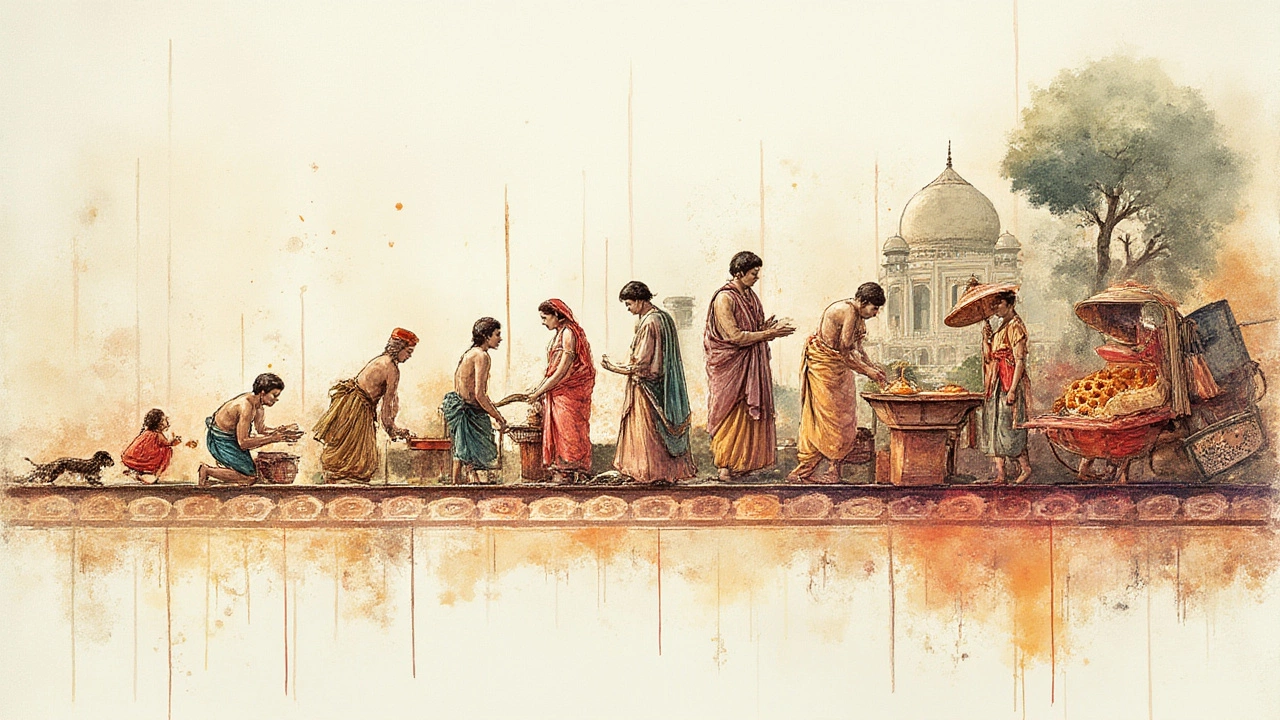Picture this: a sweet so old, its origins disappear into the fog of legend. It isn't just a treat—it's a tasting note from a civilization older than the pyramids, a dessert whispered about since Sanskrit was the latest high-tech. India, home to one of the world’s oldest food traditions, has a dessert that predates nearly every culinary craving we can trace. So, which ancient masterpiece claims the title of India’s oldest known dessert? It isn’t gulab jamun, halwa, or even the festival favorite laddoo. Step aside, modern sweets—the real OG is kheer, a creamy rice pudding loved for at least 2,000 years.
The Ancient Story Behind Kheer
When you ask Indians about comfort food, many will tell you it’s kheer—the dessert that turns up at weddings, birthdays, and every holy ritual, from Punjab to Kerala. But kheer isn’t just a staple of celebrations; it’s woven into India's earliest stories and ceremonies. The first recorded mention of kheer appears in the ancient Sanskrit text, the Jaiminiya Brahmana, dated to the Vedic period—around 1,000 BCE. That makes kheer more than three millennia old. Historians believe its earliest form was called ‘payasa’ (from the word ‘payas’, meaning milk), made by simmering rice in milk and sweetening it with honey or jaggery. These basic ingredients—milk, rice, and something sweet—have been around in Indian households for ages. According to food historian K.T. Achaya, “There are temple inscriptions dating back a thousand years detailing the offering of payasa to deities,” showing its deep spiritual roots.
Kheer’s recipe hasn’t strayed far since ancient times, but every region in India puts its own spin on it. South India calls it payasam and might use coconut milk or vermicelli instead of rice, while the North clings to fragrant basmati rice, cardamom, and a shower of nuts. Some old Bengali versions even throw in date palm jaggery. Yet at heart, it remains a creamy, comforting pudding that symbolizes prosperity, purity, and joy. Fascinatingly, kheer wasn’t just food—it was seen as a sacred offering, bridging the earthly and divine. Some say it was prepared for victorious warriors or as nourishment for monks. In Hindu temples, payasa is still offered as prasad during major festivals. It’s not just dessert; it’s almost magical—imagine passing a ladle of kheer steeped in stories as old as the Mahabharata.
Kheer’s Role Through Indian History
Kheer’s story is inseparable from the spread of rice cultivation in the Indian subcontinent. As rice traveled eastward and became more widely grown around 600 BCE, dishes like kheer gained prominence—and not just among nobles. Even commoners enjoyed it at communal celebrations. When Buddhist monks travelled from India, they took recipes for kheer along, giving rise to sweet rice puddings in places like Sri Lanka and Southeast Asia. If you see Thai or Cambodian rice desserts, know that their family tree starts in ancient India.
The Mughal era brought lavishness to kheer—rose water, saffron, dried fruits, and expensive spices changed it from plain pudding to royal indulgence. Akbar’s chef is rumored to have served a saffron-infused version to the emperor. During British rule, rice pudding took a Western detour; but no English custard could upstage kheer’s old-school charm. Even after several centuries, kheer is still found everywhere in India’s cultural DNA. You’ll spot people serving bowls to pilgrims in Varanasi, making big pots to break Ramadan fasts, or preparing it for child-naming ceremonies from Kashmir to Tamil Nadu. It's mind-boggling how one dessert connects so many moments in Indian history.
Here’s a quick look at just how far and wide this dessert has travelled in the subcontinent:
| Region | Name | Special Twist |
|---|---|---|
| North India | Kheer | Basmati rice, cardamom, saffron, nuts |
| South India | Payasam | Jaggery, coconut milk, vermicelli |
| Bengal | Payesh | Date palm jaggery, bay leaf |
| Maharashtra | Shevayachi Kheer | Vermicelli instead of rice |
| Odisha | Chhenapoda Payasa | Chhena (ricotta cheese), rice, milk |

How Kheer Became India’s Sweet Emblem
What’s wild is how kheer became the standard for any festive or spiritual gathering. In India, food is part ritual, and kheer pretty much sets the bar for sacredness and celebration. No other dessert is eaten across every religion, region, and social class like kheer. When someone is born, kheer is prepared. A marriage? There’s kheer. Need a good luck charm before an exam? Grandma stirs up a pot of kheer. It’s the universal code for ‘something special is happening.’
Scientists have even tried to break down why kheer is so universally loved. It’s not just the creamy texture or sweet flavor—it holds nostalgia, comfort, and even a sense of community in every bite. Maybe that’s why kheer pops up at the most important milestones of life. Even famous Indian authors, like Jhumpa Lahiri, have written about eating kheer at family reunions, hinting at how this dessert carries memories through generations. Here’s a tip: For super-creamy kheer, always let it simmer slowly over low heat—patience is the secret weapon, just like the ancients did it.
Kheer might seem simple, but don’t be fooled. The dish is a culinary time capsule—each bowl a portal to the kitchens of priests, queens, villagers, and traders who all relied on the same trio of ingredients: rice, milk, and a dash of sweetness. No fancy kitchen gadgets are required, which means the earliest Indian grandmas could whip it up in mud pots over open fires. Even its simplicity is a clue to its age. Food researcher Pushpesh Pant once said, “In the complexity of Indian food, kheer stands out for its graceful simplicity, yet rich layers of meaning.”
Kheer vs. Other Ancient Indian Sweets
Some folks argue about other early Indian desserts vying for the ‘oldest’ crown—like laddoo, a sweet made from roasted chickpea flour and ghee; or pitha, a stuffed rice cake known in Eastern India. Historical records show laddoos existed around the time of Sushruta (the ancient Indian surgeon) who, according to texts as old as 500 BCE, recommended them as a medicine delivery snack. But laddoo’s earliest versions were more medicinal than indulgent.
Kheer, on the other hand, was unapologetically meant for pleasure and celebration from its very start. Halwa, another sweet favorite, only showed up in India after the Persians brought their version in medieval times—so it’s a much younger cousin. Gulab jamun, despite its royal reputation, is barely a few centuries old and likely the result of Turkish and Persian culinary influence. Kheer’s ingredients—rice, milk, sugar or honey—were available and affordable to everyone. That’s probably why it survived, unchanged, for 3,000 years. Want to see the real heritage dessert of India? It’s not buried in fancy ingredients—it’s waiting in every Indian home kitchen during festivals or family feasts.
Curious about how kheer compares in sweetness to other classic Indian desserts today? Check this out:
| Dessert Name | Main Ingredients | First Recorded Mention |
|---|---|---|
| Kheer | Rice, milk, sugar | 1,000 BCE (Jaiminiya Brahmana) |
| Laddoo | Chickpea flour, ghee, sugar | 500 BCE (Ayurvedic texts) |
| Halwa | Semolina, ghee, sugar | 11th Century CE |
| Gulab Jamun | Milk solids, sugar syrup | 16th Century CE |
| Peda | Mawa, sugar | 18th Century CE |

How to Make Classic Kheer Like an Ancient Indian
Want to bring a taste of India’s past to your own kitchen? Kheer doesn’t ask for any complicated steps or hard-to-find ingredients. Here’s a classic method passed down for generations:
- Start with full-fat milk—whole, unhomogenized if you can, to get that real creamy texture.
- Rinse and soak about 100g of basmati rice for 30 minutes.
- Bring a liter of milk to a gentle boil, then add the drained rice and let it cook on low flame, stirring every few minutes.
- Let the milk thicken and the rice get soft—that’ll take at least 30–40 minutes. Ancient cooks used mud pots for slow cooking—if you’ve got a heavy-bottom pan, use it!
- Add sugar (or jaggery, if you want that smoky taste) when the rice is cooked through. Don't add jaggery directly to hot kheer—it can split the milk. Let the pudding cool a bit first.
- For aroma, drop in a few crushed cardamom pods and maybe a thread of saffron if you’re feeling fancy.
- Toss in some chopped nuts and golden raisins, and let the whole thing cool slightly before eating—if you can resist digging in.
“If there is a single dish that connects all of India, it is kheer,” says Vir Sanghvi, a prominent Indian food writer. “It speaks to our shared past, our festivals, and the everyday joy of family life.”
Some people like to serve kheer chilled, others warm. In Odisha, rice kheer called ‘chhena payasa’ is offered daily to the Jagannath temple deities. In the South, payasam is spiked with ghee and fried cashews. Each time you taste a bowl, you’re savoring a recipe practically unchanged for thousands of years.
If you want to experiment, try using brown rice, millet, or even quinoa. Dry fruits like dates, apricots, or pistachios also give it a modern update. But even in the most basic way, kheer keeps its magic. It isn’t flashy, but it’s stood the test of time.
The next time you’re served a bowl of kheer, remember that you’re not just indulging in dessert. You’re taking part in an Indian tradition as old as the mountains themselves. That’s about as sweet—and ancient—as it gets.
